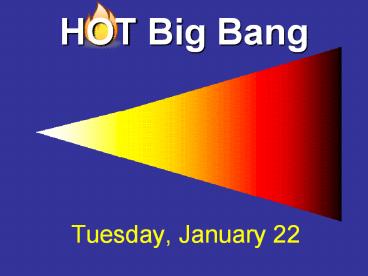HOT Big Bang - PowerPoint PPT Presentation
Title:
HOT Big Bang
Description:
Measure redshift of galaxy: (?-?0)/?0. Compute radial velocity: v = c (?-?0)/?0 ... of the interstellar gas in our Galaxy is atomic hydrogen. density 10 atoms ... – PowerPoint PPT presentation
Number of Views:126
Avg rating:3.0/5.0
Title: HOT Big Bang
1
HOT Big Bang
- Tuesday, January 22
2
Hubbles law Galaxies have
a radial velocity (v) proportional to their
distance (d).
3
Hubbles law in
mathematical form
v radial velocity of galaxy
d distance to galaxy
H0 the Hubble constant (same for
all galaxies in all directions)
4
Whats the numerical value of H0?
Whats the slope of this line? ?
5
H0 70 kilometers per second per megaparsec
(million parsecs)
Or, more concisely
H0 70 km / sec / Mpc
6
Why its useful to know H0
Measure redshift of galaxy (?-?0)/?0
Compute radial velocity v c (?-?0)/?0
Compute distance d v / H0
Cheap, fast way to find distance!
7
galaxy images
galaxy spectra
8
With modern telescopes and spectrographs,
astronomers have measured millions of spectra.
9
Kilometers per second per megaparsec?? What
bizarre units!
1 megaparsec 3.1 1019 kilometers
10
Why its intriguing to know H0
d
Two galaxies are separated by a distance d.
They are moving apart from each other with speed
v H0 d.
11
How long has it been since the galaxies were
touching?
12
PLEASE NOTE This length of time (t 1/H0) is
independent of the distance between galaxies!!
PLEASE NOTE
If galaxies speed has been constant, then at a
time 1/H0 in the past, they were all scrunched
together.
13
Heart of the Big Bang concept
At a finite time in the past (t 1/H0), the
universe began in a very dense state.
1/H0, called the Hubble time, is the
approximate age of the universe in the Big Bang
Model.
14
Since there are 3.2 107 seconds per year, the
Hubble time is
1/H0 14 billion years
15
Big Bang model de-paradoxes Olbers paradox.
If age of universe 1/H0, light from stars
farther than a distance c/H0 has not had time
to reach us.
16
Hubble time 1/H0
14 billion years.
Hubble distance c/H0
14 billion light-years 4300
megaparsecs.
17
Is the universe infinitely old?
About 14 billion years have passed since the
universe started expanding from its initial dense
state.
Food for thought what happened before the Big
Bang (that is, the start of the expansion)?
18
Is the universe infinitely big?
We dont know we can see only a region 4300
megaparsecs in radius, with no boundary in sight.
Food for thought if the universe is finite, does
it have a boundary?
19
What do I mean by a HOT Big Bang?
Hot Big Bang model the universe starts out very
hot as well as very dense.
What do I mean by HOT?
90F
9980F
212F
20
Object is hot when the atoms of which its made
are in rapid random motion.
Temperature measure of typical speed of the
atoms.
Random motions stop at absolute zero temperature.
21
(No Transcript)
22
Kelvin Celsius 273
Water boils 373 Kelvin (K) Water freezes 273
K Absolute zero 0 K
Room temperature 300 K Surface of Sun 5800 K
23
Different elements respond in different ways to
changes in temperature.
24
(No Transcript)
25
Suppose the early universe contained hydrogen,
and no other types of atom.
1 proton (positive electric charge,
mass 1.7 10-24 g)
1 electron (negative electric charge,
mass proton/1836)
26
At high density low temperature, hydrogen is a
gas of molecules.
Molecular hydrogen H2 two H atoms bonded
together
27
At low density low temperature, hydrogen is a
gas of atoms.
Much of the interstellar gas in our Galaxy is
atomic hydrogen.
density 10 atoms/cm3 T 100 K
28
At high density high temperature, hydrogen is
an ionized gas.
Much of the Suns interior is ionized hydrogen.
Suns center density 150 tons/m3 T 15
million K
29
If the temperature of the dense early universe
had been T gt 3000 K, then the hydrogen would have
been ionized.
Why does this matter?
Dense ionized gases are opaque. (You cant see
through the Sun!)
30
Why does it matter whether the early universe was
opaque?
Hot, dense, opaque objects emit light!
Today, we call hot, dense, opaque objects that
emit light stars.
31
Soon after the (Hot) Big Bang, the entire
universe was glowing.
Imagine yourself inside a star, surrounded by a
luminous, opaque fog, equally bright in all
directions.
Early universe was like that sort of
monotonous, really
32
The universe is NOT opaque today. We can see
galaxies millions of parsecs away.
The universe is NOT uniformly glowing today. The
night sky is dark, with a few glowing stars.
33
Gases cool as they expand.
(This accounts for the relative unpopularity of
spray deodorants. Woohoo, thats cold!)
34
As the hot, dense, ionized hydrogen expanded, it
cooled.
When its temperature dropped below 3000 K,
protons electrons combined to form neutral H
atoms.
The universe became transparent.
35
However, light produced earlier, when the
universe was opaque, cant simply disappear.
It radiates freely through the transparent
universe, and should still be visible today!
36
The holy grail of science an observation you
can make that will support or disprove a theory.
For the Hot Big Bang, holy grail was discovering
the leftover light from the early, opaque
universe.
37
The leftover light was discovered in the 1960s
by Bob Wilson Arno Penzias.
Astronomers call the leftover light the Cosmic
Microwave Background.
Why microwave? Thereby hangs a tale Thursdays
tale.
38
Thursdays Lecture
The Early Universe
Reading
none































![PDF Die Hot with a Vengeance: Essays on Vanity [PDF] PowerPoint PPT Presentation](https://s3.amazonaws.com/images.powershow.com/10100953.th0.jpg?_=20240816063)